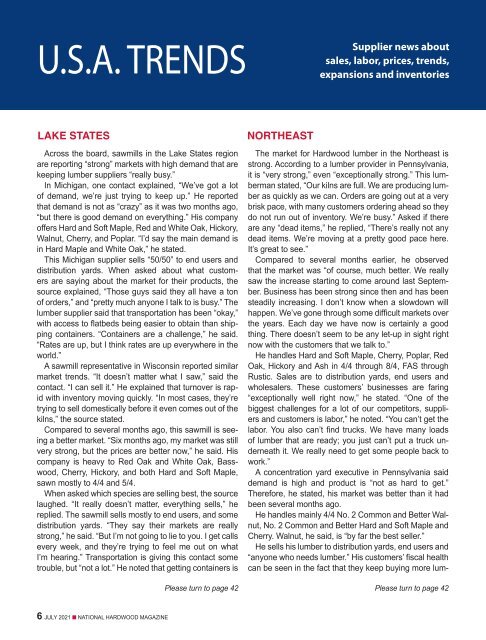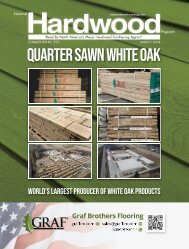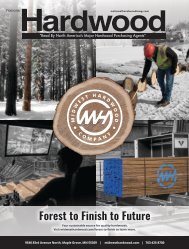National Hardwood Magazine - July 2021
In this issue of National Hardwood Magazine, learn about Mans Lumber and Millwork, Prime Lumber Company and Woods on Wheels. The issue also features highlights from the Appalachian Lumbermen and Southwestern Hardwood Manufacturers Club meetings.
In this issue of National Hardwood Magazine, learn about Mans Lumber and Millwork, Prime Lumber Company and Woods on Wheels. The issue also features highlights from the Appalachian Lumbermen and Southwestern Hardwood Manufacturers Club meetings.
Create successful ePaper yourself
Turn your PDF publications into a flip-book with our unique Google optimized e-Paper software.
U.S.A. TRENDS<br />
Supplier news about<br />
sales, labor, prices, trends,<br />
expansions and inventories<br />
LAKE STATES<br />
NORTHEAST<br />
SOUTHEAST<br />
WEST COAST<br />
Across the board, sawmills in the Lake States region<br />
are reporting “strong” markets with high demand that are<br />
keeping lumber suppliers “really busy.”<br />
In Michigan, one contact explained, “We’ve got a lot<br />
of demand, we’re just trying to keep up.” He reported<br />
that demand is not as “crazy” as it was two months ago,<br />
“but there is good demand on everything.” His company<br />
offers Hard and Soft Maple, Red and White Oak, Hickory,<br />
Walnut, Cherry, and Poplar. “I’d say the main demand is<br />
in Hard Maple and White Oak,” he stated.<br />
This Michigan supplier sells “50/50” to end users and<br />
distribution yards. When asked about what customers<br />
are saying about the market for their products, the<br />
source explained, “Those guys said they all have a ton<br />
of orders,” and “pretty much anyone I talk to is busy.” The<br />
lumber supplier said that transportation has been “okay,”<br />
with access to flatbeds being easier to obtain than shipping<br />
containers. “Containers are a challenge,” he said.<br />
“Rates are up, but I think rates are up everywhere in the<br />
world.”<br />
A sawmill representative in Wisconsin reported similar<br />
market trends. “It doesn’t matter what I saw,” said the<br />
contact. “I can sell it.” He explained that turnover is rapid<br />
with inventory moving quickly. “In most cases, they’re<br />
trying to sell domestically before it even comes out of the<br />
kilns,” the source stated.<br />
Compared to several months ago, this sawmill is seeing<br />
a better market. “Six months ago, my market was still<br />
very strong, but the prices are better now,” he said. His<br />
company is heavy to Red Oak and White Oak, Basswood,<br />
Cherry, Hickory, and both Hard and Soft Maple,<br />
sawn mostly to 4/4 and 5/4.<br />
When asked which species are selling best, the source<br />
laughed. “It really doesn’t matter, everything sells,” he<br />
replied. The sawmill sells mostly to end users, and some<br />
distribution yards. “They say their markets are really<br />
strong,” he said. “But I’m not going to lie to you. I get calls<br />
every week, and they’re trying to feel me out on what<br />
I’m hearing.” Transportation is giving this contact some<br />
trouble, but “not a lot.” He noted that getting containers is<br />
The market for <strong>Hardwood</strong> lumber in the Northeast is<br />
strong. According to a lumber provider in Pennsylvania,<br />
it is “very strong,” even “exceptionally strong.” This lumberman<br />
stated, “Our kilns are full. We are producing lumber<br />
as quickly as we can. Orders are going out at a very<br />
brisk pace, with many customers ordering ahead so they<br />
do not run out of inventory. We’re busy.” Asked if there<br />
are any “dead items,” he replied, “There’s really not any<br />
dead items. We’re moving at a pretty good pace here.<br />
It’s great to see.”<br />
Compared to several months earlier, he observed<br />
that the market was “of course, much better. We really<br />
saw the increase starting to come around last September.<br />
Business has been strong since then and has been<br />
steadily increasing. I don’t know when a slowdown will<br />
happen. We’ve gone through some difficult markets over<br />
the years. Each day we have now is certainly a good<br />
thing. There doesn’t seem to be any let-up in sight right<br />
now with the customers that we talk to.”<br />
He handles Hard and Soft Maple, Cherry, Poplar, Red<br />
Oak, Hickory and Ash in 4/4 through 8/4, FAS through<br />
Rustic. Sales are to distribution yards, end users and<br />
wholesalers. These customers’ businesses are faring<br />
“exceptionally well right now,” he stated. “One of the<br />
biggest challenges for a lot of our competitors, suppliers<br />
and customers is labor,” he noted. “You can’t get the<br />
labor. You also can’t find trucks. We have many loads<br />
of lumber that are ready; you just can’t put a truck underneath<br />
it. We really need to get some people back to<br />
work.”<br />
A concentration yard executive in Pennsylvania said<br />
demand is high and product is “not as hard to get.”<br />
Therefore, he stated, his market was better than it had<br />
been several months ago.<br />
He handles mainly 4/4 No. 2 Common and Better Walnut,<br />
No. 2 Common and Better Hard and Soft Maple and<br />
Cherry. Walnut, he said, is “by far the best seller.”<br />
He sells his lumber to distribution yards, end users and<br />
“anyone who needs lumber.” His customers’ fiscal health<br />
can be seen in the fact that they keep buying more lum-<br />
The <strong>Hardwood</strong> markets in the Southeast are “very<br />
good.” That’s the word from a lumber provider in Virginia.<br />
It’s a sentiment echoed by other lumber companies in<br />
the region.<br />
The Virginia source also said the market for her company<br />
is “much better” than it was a few months ago.<br />
“Prices are higher, and all lumber is moving,” she stated.<br />
She handles Red and White Oak, Poplar and Walnut<br />
in 4/4 through 10/4 in No. 3 Common and Better. Her<br />
sales are to domestic distribution yards and exporters.<br />
Her customers’ sales are good, she noted.<br />
Transportation is not a problem for her because, she<br />
observed, “I have local truckers we’ve worked with for<br />
years. They cover us when I need it.”<br />
In Georgia, an international lumber supplier observed<br />
that everything in his company’s business is strong – with<br />
one exception. “The problem is getting logs,” he stated.<br />
“We’re just now starting to get a few logs coming in. It<br />
doesn’t matter what the price is if you don’t have any<br />
lumber to sell. The entire pipeline from the woods to the<br />
customer is pretty much depleted. There’s not a whole<br />
lot of kiln-dried inventory. There’s not a whole lot of in<br />
process, air-drying. There’s not a ton of containers on the<br />
water. The distributors’ warehouses and the customers’<br />
warehouses are empty. So, it’s going to take a while to<br />
fill that pipeline up. If we start getting logs tomorrow, it’s<br />
four months at a minimum by the time we get it sawn,<br />
air-dried, kiln-dried, graded and ready to put in a container.<br />
It’s going to be awhile before we overcome this<br />
shortage.”<br />
His market, he noted, is “considerably better” than it<br />
was in the recent past. “We’ve got a little bit of wood coming<br />
through the system. I think you’ll see the <strong>Hardwood</strong>s<br />
pick up. But we’ll always keep some pine in the system.”<br />
Among <strong>Hardwood</strong>s, he handles Red and White Oak,<br />
Poplar and Ash in 4/4 in all standard grades. “All of these<br />
species are selling well,” he stated. “It’s not a difficult situation.<br />
You consider which customer has been with you<br />
the longest, and you support the ones who have worked<br />
with you up to this point. You ration the lumber among<br />
Out on the West Coast, lumber providers report the<br />
same phenomenon that is occurring across the country:<br />
high demand and low supply.<br />
A Washington lumberman stated, “People are hungry<br />
for lumber. They are definitely freaked out about the<br />
pricing changing so fast. So, there’s demand for a lot of<br />
species, and supply is tight.”<br />
Compared to six months earlier, his company is financially<br />
better. “But it is a struggle to operate, between finding<br />
the lumber and, definitely, issues with trucking. Problems<br />
with transportation have been going on all year. It<br />
is getting continuously worse. All freight costs are up 40<br />
percent since November and December.”<br />
He handles most all eastern species: Red and White<br />
Oak, Poplar, Hard and Soft Maple, Walnut and Hickory,<br />
primarily 4/4 and some thicker stock. Grades are mainly<br />
upper but with Common grades, as well. “All species are<br />
moving well, if we can get a fair price, we can move it,”<br />
he stated. “From the time a vendor tells us the lumber is<br />
available, we call our customers and within half an hour,<br />
we have it sold. However, it’ll take weeks to get it moved<br />
with the trucking situation.”<br />
He sells to end users, distribution yards and sawmills,<br />
which buy green and kiln-dried lumber from him. “Some<br />
mills don’t produce everything they need or are in short<br />
supply, so they buy from us to supplement when they<br />
have to,” he explained. Many of his customers are in<br />
the housing industry – cabinets, flooring, moulding, stair<br />
treads: “We pretty much cover them all.” He also sells to<br />
RV manufacturers. “But the housing industry seems to<br />
be the real driver,” he said.<br />
Compared to several months ago, he said, “It takes<br />
two times as long to get trucks as it used to. There are<br />
just not as many trucks available, and prices have gone<br />
way up.”<br />
An Oregon lumber provider stated, “The market is robust,<br />
but unfortunately the supply chain is very limited.<br />
We could sell a lot more product, but getting replacement<br />
product in is challenging. The reality is: there’s a<br />
shortage of labor. It starts there, and it ends there. The<br />
Please turn to page 42 Please turn to page 42<br />
Please turn to page 43 Please turn to page 44<br />
6 JULY <strong>2021</strong> n NATIONAL HARDWOOD MAGAZINE JULY <strong>2021</strong> n NATIONAL HARDWOOD MAGAZINE 7


















